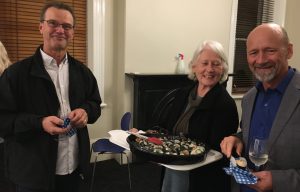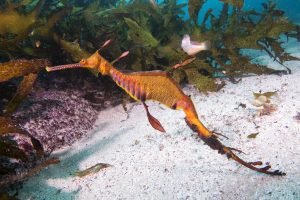Elizabeth Dark, Regina Haertsch, Peter Simpson-Young and Andrew Wood, Bulletin 5/2021 July 2021
The Society’s sixth annual biodiversity lecture was given by John Turnbull, a Research Fellow from the School of Biological, Earth and Environmental Sciences at the University of New South Wales, on 1 June at Benledi House, Glebe Library.
His talk was entitled ‘Biodiversity on our blue doorstep – fascinating creatures in Sydney harbour and coastline’ and was attended by 40 Society members and friends – a full house. The annual lecture is made possible by the generous donations to the Blue Wren Subcommittee from the Estate of the late Jan Craney (a former Convenor of the Subcommittee), Robert Hannan, Norma Hawkins, Mary Holt and Roberta Johnson.

This was a night not to be missed – not only for the knowledge John had about his subject but also for his commitment to promoting the health and conservation of our marine ecology and for the way he held our attention on the night. John is one of Australia’s leading experts in Sydney’s marine wildlife and conducts large surveys with the help of passionate local divers and citizen scientists.
We are fortunate to have a harbour with such marine biodiversity – Sydney Harbour has over 600 endemic species of marine wildlife. John pointed out that the number of fish species in our Harbour alone, compares to the entire coastline of the UK. He explained that ocean currents, like the Eastern Australian Current (famously depicted in the movie Finding Nemo), make it difficult for marine wildlife to migrate away from the region, resulting in the local animals evolving in isolation.
The wildlife in Sydney’s ocean is as unique as Australia’s wildlife on land.
There were a lot of insights with John’s awards for special characteristics of different species including those for:
- the ‘most successful’ fish (eastern hulafish)
- the ‘most colourful’ fish (eastern blue devil fish)
- the ‘most intelligent’ local (octopus)
- the ‘best invisibility cloak’ (cuttlefish)
- the ‘I’m happiest to see you’ fish (blue groper, NSW’s State Fish)
- the ‘hardest to believe you’ fish (seadragon that nourishes the eggs of its young until they hatch)
- the ‘most melancholy’ fish (seahorse which has a prehensile tail and the young are carried to full term by the male seahorse)
- the ‘better than floriade’ award (sponge gardens).

After hearing about the colourful world below the water in our harbour, John’s points about the pressures from human fishers on our marine ecology added a thoughtful end to the evening and what we want for the future. For example, line-fishing and spearfishing selectively target the predatory fish which would otherwise help regulate sea-urchin populations, and their numbers have sky-rocketed leading to decimation of critical kelp forests.










There are no comments yet. Please leave yours.